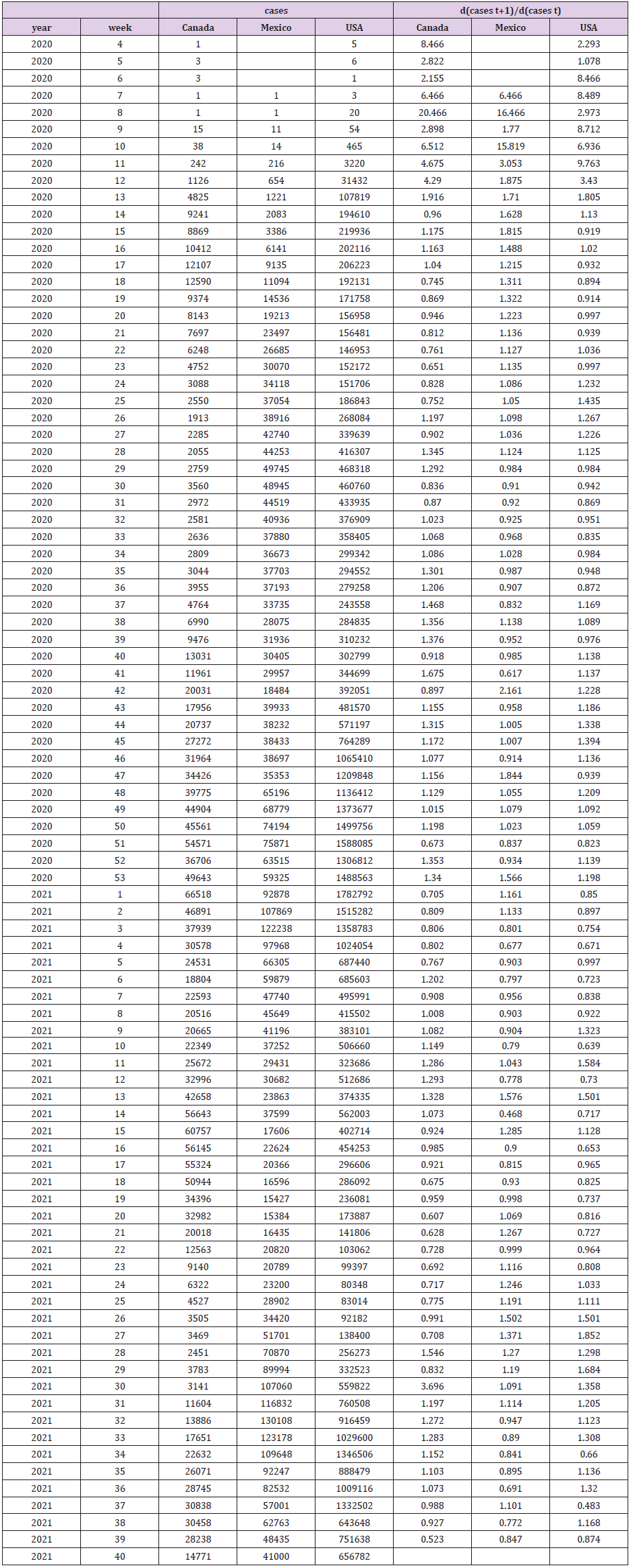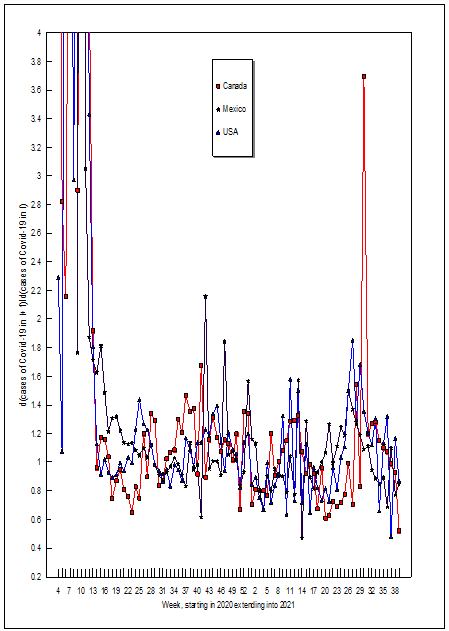The Spread Rate of Covid-19 in North America
Introduction
Leightner, Inoue, and Lafaye de Micheaux [1] are the first
researchers to apply a variable slope estimation procedure to the
spread of an infectious disease – Covid-19 [2]. They applied this
technique to data from Brazil, Europe, South Africa, the United
Kingdom, and the USA for early 2020 to the end of March 2021.
They used weekly data on the number of “new” Covid-19 cases
to estimate the change in “new” Covid-19 cases next week due to
one more “new” Covid-19 case this week. I follow what they did in
some ways and deviate in others. Specifically, I continue to use a
one week lag because the Center for Disease Control [3] says that
the medium incubation period for Covid-19 is four to five days and
the data available for North America is weekly. However, I deviate
from what Leightner, et al. [1] did by using the number of cases of
Covid-19 in time periods t and t + 1 instead of the number of “new”
Covid-19 cases. I made this change because all current cases of
Covid-19 can spread the disease, not just “new” cases. Leightner,
et al. [1] data ended in March of 2021, but the data for this paper
extends through October 9, 2021.This extension of the data is
important because the Delta variant of Covid-19 hit North America
after March of 2021, and the Delta variant is much more infectious.
Finally, I find estimates for the spread rate of Covid-19 in Mexico
and Canada – two countries not examined by Leightner, et al. [1].
I use the same variable slope estimation technique employed by
Leightner, et al. [1] which is Reiterative Truncated Projected Least
Squares (RTPLS).
Materials and Methods
The data was downloaded from the webpage of the European Centre for Disease Prevention and Control (2021) [4]. I began the data series for each country at the point when that country’s number of Covid-19 cases remained above one for the rest of the data set. This resulted in Canada’s and the USA’s data starting in the fourth week of 2020 and Mexico’s data starting in the seventh week of 2020. The data is presented on the left side of Table 1 and depicted in Figure 1. Leightner, et al. [1] use simulation tests to compare and contrast three different variable slope estimation methods – variable slope ordinary least squares (VSOLS), variable slope generalized least squares (VSGLS), and reiterative truncated projected least squats (RTPLS). Although VSGLS is theoretically the best linear unbiased estimate (BLUE), Leightner, et al. [1] used RTPLS because simulations show that RTPLS produces noticeably less error than VSGLS when all the variation in the dependent variable is due to omitted variables and RTPLS captures non-linear relationships better than VSGLS and the spread of a disease is nonlinear [5]. Simulations show that VSOLS was always far inferior to both VSGLS and RTPLS.
All three variable slope estimation methods are built upon the
following ideas:
(1) Omitted variables destroy the reliability of estimated
coefficients and statistics when they affect the estimated slope
(if an omitted variable does not affect the slope in the sample
or population, then it merely adds more random noise to the
estimation, and does not bias the estimates),
(2) If omitted variables affect the estimated slope and they are
ignored, then the estimation procedure produces a constant
slope, when in truth the slope varies due to the omitted
variables (thus the resulting estimates are hopelessly biased),
and
(3) Omitted variables will affect the relative vertical position of
observations [6].
All three variable slope estimation procedures use the relative vertical position of observations to capture the influence of omitted variables; all three produce a separate slope estimate for every observation where differences in these slope estimates are due to omitted variables. Variable slope estimation produces estimates that show all the ways that the dependent and independent variables are related (i.e. total derivatives); in contrast to more traditional estimation techniques which produce estimates holding all other included variables constant (thus, partial derivatives). Leightner, et al. [1] explain all three variable slope estimation procedures, test all three using simulations, and then uses RTPLS to estimate the spread rate of Covid-19 as described above. Leightner, et al. [7] and Leightner [8] explain RTPLS and present the mathematical equations used in it. Both Leightner, et al. [1] and Leightner, et al. [7] are open access articles. Published applications of RTPLS include estimates of the inflation/unemployment tradeoff, pollution abatement, effectiveness of monetary, fiscal, exchange rate, and trade policies, and the effects of China accumulating US dollars on the value of the US dollar and on the US trade deficit.
Results
Figure 1 plots the data over time. The two upward spikes in the number of Covid-19 cases in the USA correspond to new variants of the virus. Variant B.1.1.7 hit the world in September 2020 (≈week 38) and the Delta variant hit North America in June of 2021 (≈week 25) (Center of Disease Control and Prevention, 2021) [9]. Figure 1 shows that Mexico and Canada also experienced these new variant spikes (although Canada’s Delta spike occurred with a 6 week lag). The noticeable declines in Covid-19 cases in early 2021 in all three countries corresponds to when vaccines were first available. The estimates for d(cases of Covid-19 in t+1)/d(cases of Covid-19 in t) are given in the right half of Table 1 and depicted over time in Figure 2. The d(cases of Covid-19 in t+1)/d(cases of Covid-19 in t) estimates are highest and most unstable when Covid-19 first emerged in each country. The d(cases of Covid-19 in t+1)/d(cases of Covid-19 in t) value for Canada in the fourth week of 2020 means that an additional case in that week would be correlated with 8.466 additional cases the next week. A close examination of Figure 2 reveals some common trends for all of North America: (1) from 2020 week 13 through the end of 2020 d(cases of Covid-19 in t+1)/ d(cases of Covid-19 in t) estimates were on an upward trend, (2) d(cases of Covid-19 in t+1)/d(cases of Covid-19 in t) fell in early 2021 as vaccinations become available, (3) d(cases of Covid-19 in t+1)/d(cases of Covid-19 in t) again rose between weeks 4 and 13 of 2021, then fell between weeks 14 and 22, rose again between weeks 21 and 30, and then fell after week 30 of 2021.
Discussion
It should be noted that the estimates of d(cases of Covid-19 in t+1)/d(cases of Covid-19 in t) given in Table 1 and depicted in Figure 2 are for both increases and decreases in the number of cases in time t. However, every time the estimate of d(cases of Covid-19 in t+1)/d(cases of Covid-19 in t) was less than one, Covid-19 cases declined the next time period. This means that if Canada, Mexico, and/or the USA could reduce the number of cases in time t by one [perhaps by stricter social distancing laws, mandating vaccines, or rapid testing and quarantining [10], then the number of cases in time t+1 would decline by less than one. However, if something (like a new Covid-19 mutation or more humid, cooler weather) would increase the number of Covid-19 cases in time t, then the number of cases in time t+1 would increase by more than one. Thus it is harder to kill this virus than it is for it to spread. Governments and people need to do all that they can to beat this virus, because it is easier to spread than it is to defeat.
For more Articles on : https://biomedres01.blogspot.com/





No comments:
Post a Comment
Note: Only a member of this blog may post a comment.